Le Teich, Gironde, Nouvelle-Aquitaine 作者: 来源: 发布时间:2021-09-24
I.Population and Area
Total Area: 12 km2
Population in 2017: 5 539
Population Density: 462 /km2
Histogram of demographic change
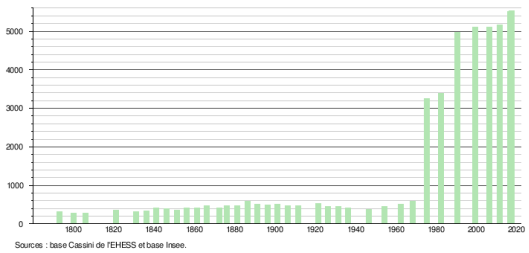
II.Natural Geography (environment and resources)

Le Teich is a town in the southwest of France, in the department of Gironde, in the Nouvelle-Aquitaine region.
Le Teich, east of Arcachon, is located on the Eyre delta in Pays de Buch, south of the Bassin d'Arcachon and is part of the Landes de Gascogne Regional Natural Park. The town borders the Landes department.
Communication routes and transport: It can be accessed by the French A660 motorway (exit no 3) as well as by train: the Teich station is located on the Lamothe - Arcachon line and is served by the Nouvelle-Aquitaine TER connecting Bordeaux to Arcachon. Baïa network buses serve the town (lines 5 and 6).
III.ECONOMY
Employment rate (%): 77.5 (2017)
Poverty rate by age group of the tax advisor(%): 9 (2017)
Average employment income (€):2 353 net per month (28 237 net per year)(2014)
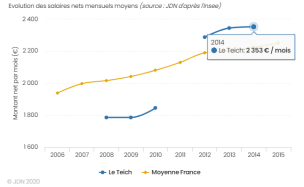
Evolution of average monthly net wages
Sources : http://www.journaldunet.com/business/salaire/le-teich/ville-33527
https://www.insee.fr/fr/statistiques/2011101?geo=COM-33527
IV.Industrial Characterisitics
The municipality has made the choice to develop the economy and employment by relying on three pillars: the activity, craft and industrial zones in Sylvabelle, the tertiary sector in Technoparc, local commerce in the center and in the traffic circle. Boulange point, and nature tourism around the port. Our municipality is thus always more attractive. Le Teich has the highest rate of business creation in COBAS according to statistics from the Chamber of Commerce and Industry.
TECHNOPARC
As part of its regional planning policy, COBAS has decided to initiate an economic, urban and landscaped project for the main entrance site of the agglomeration, on the edge of the Teich motorway interchange. activities - Economic life
This intercommunal dimension project aims to constitute the tertiary and technological activity park emblematic of the urban community. It is part of both the dynamic opened up by the great Lasers Route project and the sustainable development strategy defined by the COBAS territory project.
On an area of 23 hectares, it is envisaged a global construction program of 88,000 square meters of SHON taking into account the imperatives of sustainable development: from the orientation of the buildings to their insulation through the use of natural materials, all has been designed with the aim of protecting the environment.
A first phase has been completed and includes a business center of 1000 modular square meters, a panoramic brasserie with 80 seats and a hotel with 49 rooms based on the concept of "all suites home" tourist residences.
A second phase which is marketed completed this development and very soon a third phase will be engaged.
SYLVABELLE'S ACTIVITY AREA
Located near the railway line and the motorway interchange connecting the Arcachon Basin to the Bordeaux metropolitan area and to the main axis connecting Spain, this area is ideally located. Outside any built-up area, it authorizes the development of businesses present without risk of harm to the inhabitants of the municipality.
It is planned to build a new section of 10 hectares in the south as a direct extension of the already existing facilities.
THE TEICH ECOPOLE
An environmental benchmark
Located 6km south of the motorway hosts the COBAS sorting and recycling center for recyclable waste. A second environmental protection equipment has been set up there with the sorting and recovery center for sands and silts from the ports of the South Basin. This establishment, which is part of the "Grenelle de la Mer" framework, is considered by the services of the Ministry of the Environment as exemplary at the national level. During the public inquiry, environmental protection associations stressed the importance of this project, which no longer "slams" dredged products from ports at sea.
How does the sorting and recovery of sands and silt work?
Sands and silt from the ports arrive at the Ecopôle in watertight trucks. They are stored, desalted and sorted in sealed basins. Once dried, the clean sands and mud leave the center and are used as road underlayments by construction companies. Sorting residues will also be evacuated to approved storage centers. No material remains on the recovery and sorting site.
Recipes for our municipality
This establishment represents an annual revenue for the municipality of € 50,000, or the equivalent of two local tax points that the inhabitants of Teich will not pay. Added to the 72,800 € of revenue from the COBAS sorting and recovery center, the Ecopôle will provide the municipality with direct revenue of 122,800 € each year. We must also add the rent for geothermal energy at the Esturgeonnière, which represents € 22,500 per year.
It is a green economy, a local environment-friendly economy that creates jobs that is developing in Teich and generates a total revenue of € 145,300 per year, or the equivalent of six tax points.
Sources: https://leteich.fr/votre-quotidien/vie-economique/
https://leteich.fr/votre-quotidien/vie-economique/zone-activites/
V.Attractions
1.HOUSE OF NATURE OF THE ARCACHON BASIN
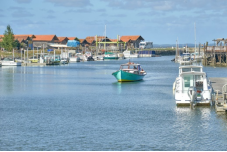
Between land and sea, all clad in wood, immersed in the middle of birds and reeds, the MAISON DE LA NATURE DU BASSIN D'ARCACHON is one of the 3 centers for environmental education and discovery of the Landes Regional Natural Park of Gascony of which it constitutes the maritime entry.
Nestled on the banks of the Leyre Delta, a stone's throw from the Arcachon Basin, the Maison de la Nature du Bassin d'Arcachon is located at the entrance to the Teich Ornithological Park, which in a way constitutes its secret garden. Open all year round, it has quality group accommodation, labeled Gite de France, which welcomes groups of all kinds all year round, from educational stays to relaxing stays.
It has an entertainment service which is available to all groups to supervise these moments of discovery; whether on foot, by canoe, sea kayak or fishing boat, all the most peaceful means are used to take the visitor from the depths of the forest to the rugged shores of the ocean.
The Maison de la Nature benefits from all the essential amenities (regional directorate for youth and sports, academic inspection, FFCK nature canoe and sea kayak point label).
2.PORT OF TEICH
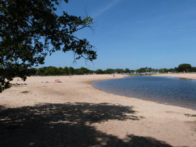
Adapted swimming, located in the tourist area between the port and the Leyre, is supervised (in the delimited area) from July 1 to August 31, from 1:45 p.m. to 7 p.m. Outside these periods and the delimited area, swimming is practiced at your own risk.
This surveillance is materialized by a flag on the mast provided for this purpose. Swimming is open to the public free of charge.
A municipal decree of June 5, 2008 provides that groups and holiday camps must request authorization from the town hall services to go swimming (download from this page).
In addition, groups and holiday camps must have BNSSA or SB staff with AFPS and report their presence to the security manager. They must comply with the instructions and signals of the security manager.
According to the regulations in force, the existence of a monitoring service does not relieve the supervision and management of holiday groups and camps from their own responsibility.
3.Ruat Castle
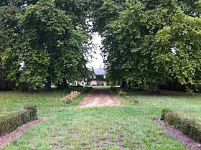
The castle of Ruat is a castle located in the town of Teich, in Gironde.
Originally, the “Techys” castle (currently spelled Le Teich) was part of the defense system of the Arcachon Basin, between the castles of La Teste and Certes, owned by the captives of Buch.
In 1300, Rufat 1er d'Artiguemal, by becoming vassal of Pierre-Amanieu de Bordeaux († 1300), captal of Buch, received in exchange for his loyalty and a golden spearhead, the small fiefdom made up of the castle of Techys and surrounding land. He will thus give his name, which means with red or spiky hair (from the Latin Rufatus derived from Rufus), to the castle Rufat or Ru (h) at (the f giving an aspirated h in Gascon).
In 1425, the estate was transmitted (by marriage) to the Casteja family, who remodeled the castle (current bases dating from the fifteenth century) separating the defense from the mouth of the Eyre located 400 m further south, on the edge Swamps. The Casteja remained vassal of the captal of Buch: lord with a prestigious title, illustrated in the Middle Ages by Jean III de Grailly faithful to the crown of England and formidable adversary of Bertrand Duguesclin, but who had to go to the battle of Castillon (1451) , which ended the Hundred Years War. The goods of the captives of Buch were then confiscated by Charles VII.
Louis XI returned their property to the captals of Buch for diplomatic reasons. In 1468, returning from exile, Jean de Foix-Candale found his seigneury of Buch largely depopulated and granted a first bail giving property on the Great Mountain to whoever undertook to exploit it while retaining a right of ownership. 'use for him and the inhabitants of La Teste, Gujan and Cazaux. In 1500, the captalate of Buch underwent an inheritance division with the creation of the captalate of Certes integrating Le Teich.
In 1628, Jean Castaing dit le “Broy” (le Joli), merchant from La Teste, bought the Ruat estate after having bought the barony of Audenge in 1620. His daughter Jeanne married Pierre Damanieu, captain of the Château de Certes. His son Pierre II, who succeeded him, became “Captain Commandant for the King in the Captalate of Buch and neighboring countries”. The latter distinguished himself in particular during the Fronde where he delivered the castle of La Teste, but had to bombard the castle of Certainly owned by the Marquis de Civrac, and of which he was captain, in order to overcome the insurgents. In thanks, he was knighted by the king in 1654 and took the name of Amanieu de Ruat, but was assassinated in 1675 by the son of the sieur marquis de Civrac and other people or servants of his house.
In 1713, Jean-Baptiste Amanieu de Ruat, Baron d'Audenge, adviser to the Parliament of Bordeaux, bought the captalate of Buch from its last holder. In constant conflict with the Lord of Certes, he ended up agreeing a consolidation agreement (1730) notably abandoning his barony of Audenge and recovering the parish of Teich, the Eyre becoming the natural limit of their respective territory. Jean-Baptiste Amanieu de Ruat was buried in the chapel of Ruat in the church of Teich in 1739 alongside his father, his two wives and two of his children.
Forerunners of Brémontier and Chambrelent, the Amanieu de Ruat, captals of Buch, fought against the moving sands by sowing pines on the ocean coast. In particular, they had the Teich moor drained and planted by the Nézer Company.
The Revolution left them the domain of Ruat as well as their right in the user forest. On his release from prison, François Amanieu de Ruat, the last captal, deprived of his income, found his estate largely destroyed. His son-in-law Charles de Labat, baron de Lauzac (and mayor of Teich), put the estate up for sale.
In 1846, the castlewas bought by Adrien Festugière, master of forges, who had part of it redesigned in 1847 (its current appearance). His daughter Marie, lady of honor to Princess Mathilde, married the future General Charles Espinasse, aide-de-camp and Minister of the Interior to the Emperor Napoleon III. He participated with Mac Mahon in the wars of Crimea, Algeria and finally Italy where he perished at the victory of Magenta, in 1859, at the head of his division, at 44 years old.
His son Jules was then brought up with the Prince Imperial, who continued to come to Ruat with his mother the Empress Eugenie. General Espinasse built the Lamothe station on his land to accommodate the Emperor (1st stage of the Bordeaux-Arcachon railway line). The emperor was inspired by the work of Amanieu de Ruat [ref. necessary] by ordering in 1857, the seeding of the Landes plateau of the Landes forest, which as a whole is the largest artificial forest in Europe. The main gate of the castle has remained closed in his honor.
The Ruat estate remained in the family of General Espinasse with the Fontenilliat, then in the person, currently, of Pierre-Eric Villien de Gabiole. This owner preserves the framework and the relics of the past of the captals of Buch and their successors and since the beginning of the 2000s has carried out major renovation work on the castle and its outbuildings.
The facades and roofs of the castle, excluding the round machicolated tower, have been listed as historical monuments since November 11, 1970.
Sources : https://leteich.fr/votre-quotidien/tourisme/maison-de-nature-bassin-darcachon/
https://leteich.fr/votre-quotidien/tourisme/baignade-amenagee/
VI.History
It is on the current territory of the municipalities of Teich and Biganos, on the banks of the Eyre that the first inhabitants of the Arcachon Basin, the Boïates, settled a few centuries before our era. This people has been identified since Roman times. It is thus found on the lists established by Pliny the Elder. They left traces of their burials for cremation, under tumulus or in flat graves.
Then, from the 1st century, with the arrival of the Romans, a Gallo-Roman city called Boïos and a port were founded as evidenced by the archaeological remains discovered on the site of Biganos-Lamothe. This city was a stage of the coastal road leading from Bordeaux to Dax in use from the protohistoric era and noted as one of the two routes favored by the Romans to reach the south of Aquitaine.
During the last excavations, the foundations of buildings from the Gallo-Roman and Merovingian period were brought to light, including a fanum and a warehouse.
In medieval times, in order to guard against sea invasions, several observation towers were erected around the Arcachon basin. One of them was built on the current site of Ruat Castle. It is from this primitive building that was to develop and transform from the end of medieval times until the eighteenth century what was to become the residence of the Captals of Buch.
Currently, this house is still inhabited by descendants of the famous captals of the seigneury of Buch. Note that after the visit of the Emperor Napoleon III to his Minister of the Interior, General Charles-Marie-Esprit Espinasse, husband of the lord of the lord, Adrien Festugière, the gates of the aisle were permanently closed until until today.
Le Teich is on the pilgrimage route to Saint-Jacques-de-Compostelle, via Soulac.
VII.Other information
THE TEICH ORNITHOLOGICAL RESERVE
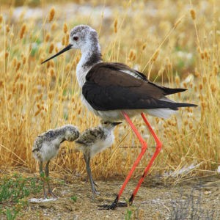
Located on one of the most important migration routes, the Arcachon basin is an essential stopover for millions of migrating birds. On the wildest shore of the basin, between the Leyre delta and the edge of the immense Gascony forest, the Teich ornithological reserve plays a major role both for the reception and protection of these migrants and for the perpetuation natural sedentary species.
The Ornithological Reserve is 120 hectares of forests, reed beds, meadows, sea marshes and lagoons, which extend from the continental sector to the sea shores of the Basin. This diversity of habitats and the richness of these natural environments attract a large number of species of birds which, using the places permanently (sedentary) or temporarily (migrating), find refuge, rest and food there.
Open to the public since 1972, La Réserve Ornithologique du Teich is owned by the municipality of Teich, which manages it with the technical assistance of the Landes de Gascogne Regional Nature Park.
The land on which it is installed was conquered from the sea in the 18th century to create a form of fish farming known locally as “fish tanks”.
As this activity fell into disuse in the 1960s, the former owners agreed to exchange these marshlands for plots of forest to the municipality.
With the advice of associations, the city of Teich and the Regional Natural Park then carried out a development program aimed at improving the biological quality of these lands and bodies of water in order to accommodate a greater number of birds. At the same time, observation equipment was installed for visitors.
Thus, for more than 30 years, the Ornithological Reserve of Teich has been inventing and creating the conditions to promote the encounter between wildlife and the respectful visitor. Open all year round, it offers well-designed routes, equipped hides and guided tours.
Today, 260 species can be observed there, 80 of which nest there, and the conservation of some rare species has earned the bird sanctuary to be recognized of international importance.
The millions of migratory birds who at one time or another in their lives have taken advantage of this protected space, the 2 million visitors who have observed them with happiness, are all there to attest to the success of this enterprise.
Sources: https://leteich.fr/votre-quotidien/tourisme/reserve-ornithologique-teich/
VIII.Contact information
LE TEICH town hall address :
64, Bis avenue de la Côte d´Argent CS 90505 33470 LE TEICH
Mayor : François DELUGA
Mail: contact@leteich.fr
Phone number: 05 56 22 33 60
Fax: 05 56 22 33 61
Website : https://leteich.fr/
Sources : https://leteich.fr/ma-mairie/vos-elus/
https://leteich.fr/
